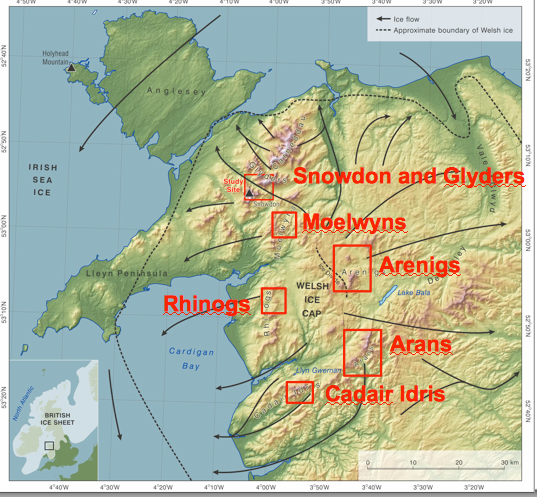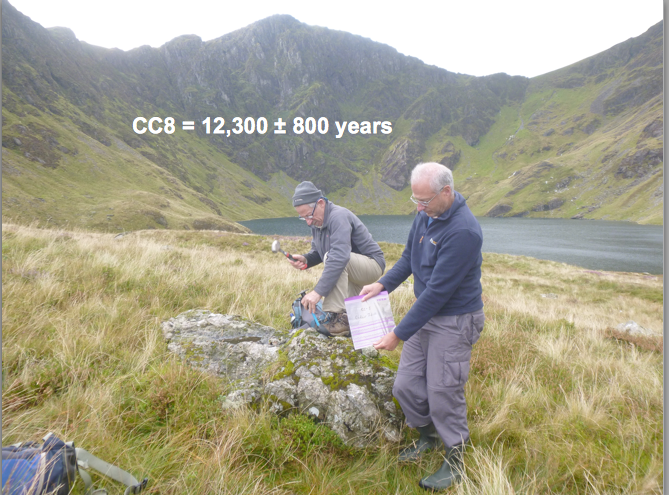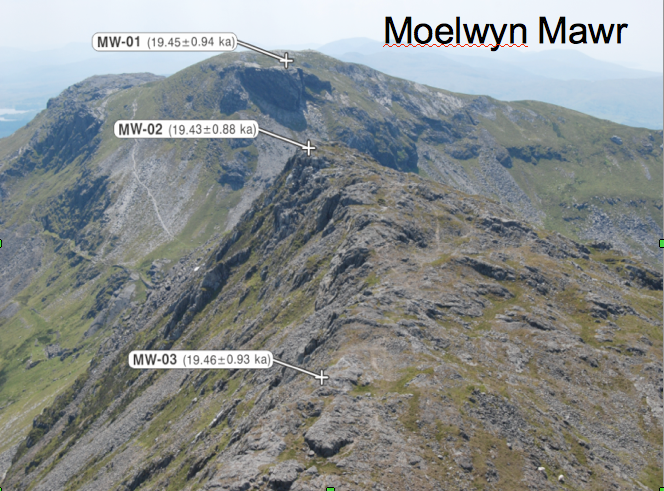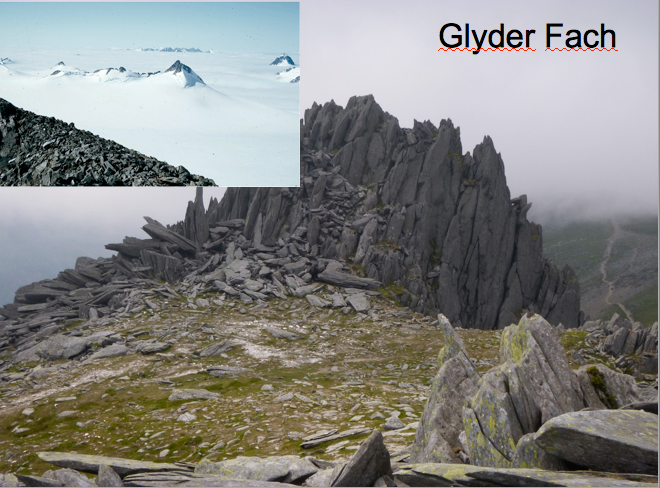New data on the Glaciations in Wales
New data on the glaciations in Wales
At the last meeting Prof. Neil Glasser gave a highly informative talk regarding new data on the glaciations in Wales based on his recent research, in collaboration with Prof. Philip Hughes of Manchester University and Dr David Fink of the Australian Nuclear Science and Technology Organisation. (ANSTO).
Their research has been ongoing for a number of years and commenced by formulating a question regarding the thickness of ice over land in Wales during the ice-ages. Were the high elevations of Wales above the ice in the form of nunataks during this time or had they been covered by the ice? This led to the research project to determine exposure ages for parts of Wales which would determine if the high elevations had been covered by ice or not and would lead to a greater understanding of glacier retreat.

Research Area
The research area targeted seven major massifs in Wales with the aim of understanding the timing of glacier retreat from summits to cirques:
Moelwyns
Arenigs
Rhinogs
Arans
Snowdon and the Glyders
Cadair Idris

Taking Samples
"In order to determine the age at which the rocks were exposed they used the method of Cosmogenic Nucleotide Dating (CND). CND uses interactions between cosmic rays and nuclides in glacially transported boulders or glacially eroded bedrock to provide age estimates for rock exposure at the earth’s surface. That is how long the rocks have been located at the surface. Cosmogenic nuclide dating is effective over short to long timescales (1,000-10,000,000 years), depending on which isotope you are dating. Different isotopes are used for different lengths of times. This long period of applicability is an added advantage of cosmogenic nuclide dating."(http://antarticglaciers.org)
Sampling strategy is important as is choosing the correct rock type. Granite and sandstone boulders are frequently used as they contain a large amount of quartz which yields 10Be and 26Al via spallation of oxygen and silicon respectively. Using these paired cosmogenic isotopes produces more reliable results than when used in isolation.
Although Prof. Glasser touched on results from previous work on some of the targeted areas his talk presented us with the latest ( still unpublished) results from work carried out on Snowden and the Glyders and Cadair idris.
His previous work has shown that the summits of the Rhinogs, Moelwyns and Arenigs in north Wales were covered by ice when the last Welsh Ice Cap was at its maximum and evidence of ice scouring and transport of glacial boulders was found. The evidence was particularly pronounced in the Rhinogs and Moelwyns. This work also provided very strong evidence that these summits became exposed as nunataks at 20–19 ka.(Hughes et al.,2016)

Other work on the Aran ridge showed that the welsh Ice Cap was thick enough to completely cover the Aran ridge and achieve glacial erosion at the Last Glacial Maximum. The work also showed that between 20 and 17,000 years ago the ridge summits were exposed as nunataks at a time when glacial erosion at lower elevations was achieved by large outlet glaciers in the valleys surrounding the mountains.( Glasser et al.,2012)

From the early works and the latest research on Snowdon and the Glyders and Cadair Idris the following conclusions have been derived:
Wales was glaciated by a large Ice cap that buried the highest mountains and transported erratics over the highest peaks in Marine Isotope Stage 4( MIS 4) 60-70,000 years ago. This latest research producing the first actual dates to show that this took place.
The highest summits of Wales then stood above the ice at LGM c 25,000 years ago.
Ice thinned quickly revealing most other summits 19-20,000 years ago after which there was only ice in the main valleys in Wales.
There was a pulse of glaciation at the Younger Dryas 12-10,000 years ago and ages for this have been obtained from both sides of Cadair Idris and also from Cwm Cau.
(Hughes PD, Glasser NF, Fink D, 2016. Rapid thinning of the Welsh Ice Cap at 20–19 ka based on 10Be ages. Quaternary Research 85: 107-117)
(Glasser NF, Hughes PD, Fenton C, Schnabel C, 2012.10Be and 26Al exposure-age dating of bedrock surfaces on the Aran ridge, Wales: evidence for a thick Welsh Ice Cap at the Last Glacial Maximum. Journal of Quaternary Science 27 (1): 97-104 )
Photos with kind permission of speaker